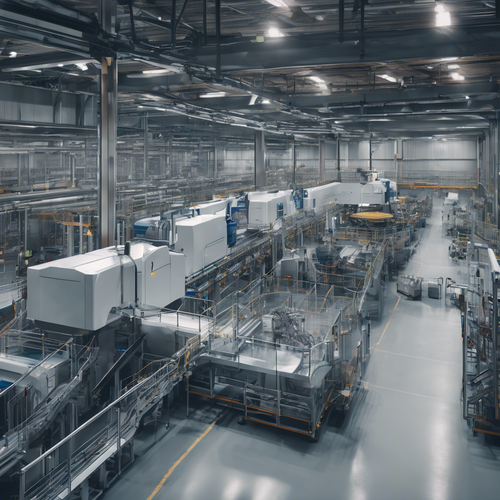Safe & Sound: Navigating Cleaning Protocols in Manufacturing Plants
Ah, the manufacturing plant—the buzzing heart of industry, where every cog in the machine works tirelessly to push the economy forward. Yet hidden behind the clatter of assembly lines and heavy machinery lies a delicate irony: for all the attention paid to production efficiency, the safety of the cleaning processes seems almost an afterthought. Cleaning these facilities is not merely about wiping down surfaces; it is a critical dance choreographed amidst potential hazards, a nuanced balance of cleanliness and caution. 🏭✨
The Need for Safety Protocols: A Matter of Life and Machinery
Every year, thousands of accidents occur in workplaces across the globe. Cleaning in manufacturing plants introduces unique hazards: slippery floors, hazardous materials, and machinery that waits for no one. As ironic as it may seem, the very tools that keep the environment sanitary can also pose significant risks. Compliance with safety regulations isn’t merely a box to check—it’s an imperative that protects the backbone of our industries: the workers.
Statistics show that more than 2.8 million workplace injuries and illnesses were reported in the U.S. alone in 2019. This staggering number underscores the importance of cultivating a culture of safety from the ground up within a manufacturing facility. The role of cleaning personnel in this paradigm can’t be overstated; they are the unsung heroes maintaining not just hygiene but also ensuring operational safety.
The Protocols: An Overarching Framework
Implementing a stringent set of safety protocols requires an understanding of both the present risks and preventative strategies. Imagine cleaning a manufacturing plant like preparing a meal following a strict recipe—each ingredient (or protocol) is crucial for a palatable outcome. Here are the fundamental protocols to consider:
- Personal Protective Equipment (PPE): The first line of defense. Employees must don appropriate PPE, such as gloves, masks, goggles, and non-slip shoes, tailored to the specific chemicals and equipment they will encounter. 💪😷
- Hazard Communication: Clear labeling of hazardous materials is essential. Employees must be trained to understand Safety Data Sheets (SDS) to mitigate risk when dealing with chemicals.
- Lockout/Tagout Procedures (LOTO): Machinery should be properly shut down and locked out before cleaning. This prevents unexpected startups—a cause of many workplace injuries.
- Slip and Fall Prevention: Use appropriate signage to denote wet floors, and consider slip-resistant cleaning products. This is not merely precautionary; in many cases, it’s a regulatory requirement.
- Regular Training and Drills: Safety isn’t a one-time lecture but a continuous conversation. Regular training and drills ensure that cleaning staff are prepared for emergency scenarios, like spills or accidents.
Innovative Tools and Practices: A Leap Forward
With rapid advances in technology, the realm of industrial cleaning is evolving. Just as a knight dons new armor, cleaning crews can utilize modern tools that elevate safety measures, like:
- Automated Cleaning Equipment: Robotic cleaners are rising stars that do not tire, misstep, or absorb hazardous chemicals. They can operate in hazardous environments, often programmed to avoid obstacles.
- Environmental Monitoring Systems: Using advanced sensors and monitoring systems to detect spills or hazardous conditions allows staff to respond swiftly and appropriately. They act like sentinels, always on watch. 🛡️
- Biodegradable Cleaning Agents: Leveraging eco-friendly products reduces exposure to harmful chemicals, fostering safer environments that are less toxic for both workers and nature.
“Innovation should not just be about productivity; it should prioritize safety, ensuring human welfare remains central,” asserts Dr. Linda Greene, a specialist in industrial safety.
Cultivating a Culture of Safety: Leadership’s Role
Cultivating a culture of safety starts at the very top—leadership must embody and advocate for safety protocols. Their commitment weaves a safety-centric thread through every operational fabric, creating an environment where workers feel empowered to voice safety concerns. This is akin to planting a tree; the roots lie hidden but support the entire structure, even in the fiercest storms. 🌳
Engaging employees in safety discussions not only fosters mutual respect but often leads to dangerous scenarios being identified before they escalate. Encouragement of reporting near-misses, shared knowledge, and even suggestions for improvements can transform a reactive safety culture into a proactive one.
Final Thoughts: Cleaning as a Craft
The art of cleaning manufacturing plants is as much about safety as it is about hygiene. Just as a craftsman takes pride in his work, so too should cleaning personnel find dignity in their role. By following safety protocols and embracing a culture of vigilance, we transform what could easily be an overlooked aspect of industry into a cornerstone of operation, marrying cleanliness with safety in a union that benefits all. 🌟
As we move towards a more industrial and mechanized future, let us not forget that behind every gleaming factory floor lies a story of hard work, careful planning, and an unwavering commitment to safety. In this great machinery we call industry, the safety protocols for cleaning manufacturing plants shine as beacons, guiding us towards a more conscientious and responsible future.
